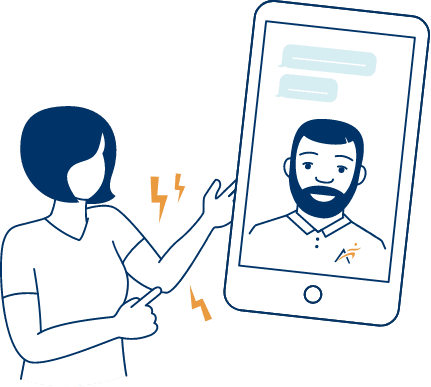(21,000+ reviews on Google across 150+ locations)
Back pain is one of the most common conditions we treat at Airrosti. Our providers can help pinpoint and resolve the root cause of your back pain, leading to complete and rapid injury resolution in 89% of cases (based on patient-reported outcomes). Learn more about our quality approach to care.
The human spine is a complex structure of bones supported by muscles, nerves, ligaments, and tendons. The segments of our spine are cushioned with cartilage-like pads called discs. Injuries or dysfunctions with any of these components can lead to back pain.
Back pain can come from a traumatic injury or develop into a chronic condition over time, lasting for months or even years. Chronic back pain can cause long-term restrictions in your overall mobility and quality of life.
Several injuries commonly associated with back pain include:
Discomfort in the upper and mid back pain is commonly caused by overuse, muscle strain, injury, poor posture, or herniated discs. One of the most common culprits of upper and mid back pain is a musculoskeletal condition called Upper Cross Syndrome.
Problems in the lower back can be caused by a variety of injuries and imbalances in the complex structure of the spine. Many people experience a low back injury from improper lifting techniques or after sitting with an excessive arch in the low back. Nerve entrapment and muscular imbalances in the hips can also contribute to low back pain. These issues often develop into painful conditions like sciatica and Lower Cross Syndrome.
Although the causes of back pain may be different depending on location and type of injury, most back injuries share similar symptoms, including:
Pain symptoms are more common the older you get, and your risk of long-term injury is increased by lack of physical activity or by carrying extra weight. Certain repetitive activities may also affect your recovery time, such as lifting, pushing, or sitting for extended periods of time.
Pain symptoms are more common the older you get, and your risk of long-term injury is increased by lack of physical activity or by carrying extra weight. Certain repetitive activities may also affect your recovery time, such as lifting, pushing, or sitting for extended periods of time.
Pain symptoms are more common the older you get, and your risk of long-term injury is increased by lack of physical activity or by carrying extra weight. Certain repetitive activities may also affect your recovery time, such as lifting, pushing, or sitting for extended periods of time
A thorough evaluation and proper diagnosis is critical to effectively treating your condition. At Airrosti, we pinpoint and treat the root cause of pain, resolving injuries in as few as three visits (based on patient-reported outcomes). Our hands-on, targeted treatment has helped numerous patients avoid unnecessary surgeries as well.
Reviewed by Casey Crisp, Doctor of Chiropractic
Disclaimer: Always consult with your doctor before starting any exercise program. If you experience any numbness, tingling or reproduction of your symptoms, please contact your doctor.

My athletic department at Westwood HS has been using Dr. Morris for the last five years with great success. After an injury to my back, I decided to give them a try for myself. I went in to see her four times and felt a significant improvement. I was very pleased with my quick recovery and professional service with everyone at her office.
by Anthony Wood
